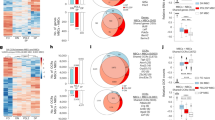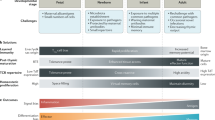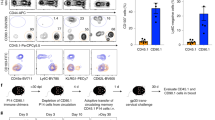Abstract
Memory is a long-recognized, crucial and poorly understood property of adaptive immunity. Jacob and Baltimore1 have designed an elegant genetic approach to marking memory T cells and their precursors irreversibly and have obtained intriguing results1,2. I suggest that the particular enzyme (human placental alkaline phosphatase) chosen for irreversible marking in postnatal life contributes to certain features of this system and perturbs the homeostatic mechanisms of T-cell activation and death.
Similar content being viewed by others
Main
Jacob and Baltimore used Cre-recombinase-mediated genetic recombination, driven by the granzyme-B promoter, to obtain irreversible and selective surface expression of placental alkaline phosphatase (PLAP; driven by the CD2 promoter) in T cells activated by antigen in adult life. In principle, this system should result in the irreversible marking of activated T cells and enhance the visualization, purification and fate mapping of activated T cells and memory T cells. As such, it should represent an invaluable tool for analysing T-cell memory, a subject central to the pathophysiology of immunity and vaccine development2.
However, this genetic marking approach yielded some unexpected and unexplained results1,2. For instance, in unimmunized mice, none of the T cells expressing high levels of CD44, which have presumably responded to environmental antigens, was positive for the PLAP marker; upon exposure to antigen, only a fraction of activated T cells became PLAP-positive. During a response to lymphocytic choriomeningitis virus (LCMV), only about 10% of LCMV-specific T cells became PLAP-positive.
Different forms of alkaline phosphatase have been described3. Human PLAP shows only limited homology to the mouse isoforms, sharing 55% identity with mouse PLAP for example4. Antibodies against human PLAP have thus been generated easily in various animal species, including mice3, so expression of human PLAP in T cells activated in adult life may result in a cellular and/or humoral anti-human-PLAP immune response.
An anti-human-PLAP response could explain some of the unusual features of the results obtained from irreversibly marking activated T cells with this human enzyme. For instance, selective pressure may favour weakly expressing T-cell clones. In general, the activation of immune responses directed against activated T cells may perturb the system in an unphysiological way.
These considerations caution against the overinterpretation of results derived from the indelible marking of activated T cells with human PLAP. To be informative, the same genetic approach should take advantage of non-immunogenic tracers.
References
Jacob, J. & Baltimore, D. Nature 399 593–597 (1999).
Rocha, B. Nature 399 531–532 ( 1999).
Millàn, J. L. & Fishman, W. H. Crit. Rev. Clin. Lab. Sci. 32 1–39 (1995).
Terao, M. & Mintz, B. Proc. Natl Acad. Sci. USA 84 7051–7055 (1987).
Author information
Authors and Affiliations
Corresponding author
Rights and permissions
About this article
Cite this article
Mantovani, A. Investigating T-cell memory. Nature 407, 40 (2000). https://doi.org/10.1038/35024159
Issue Date:
DOI: https://doi.org/10.1038/35024159
Comments
By submitting a comment you agree to abide by our Terms and Community Guidelines. If you find something abusive or that does not comply with our terms or guidelines please flag it as inappropriate.



